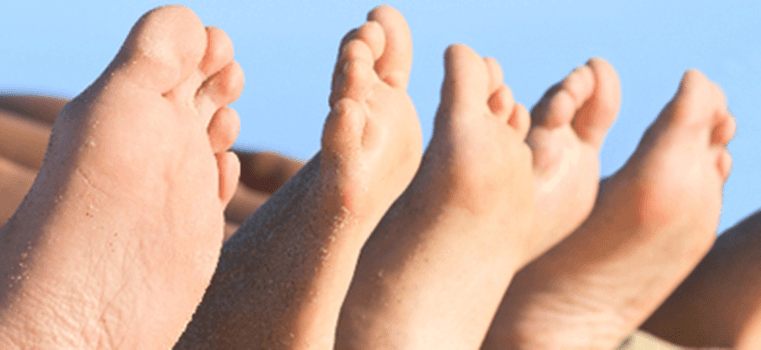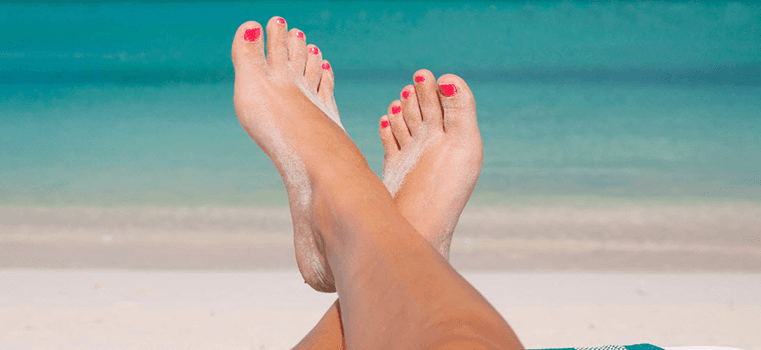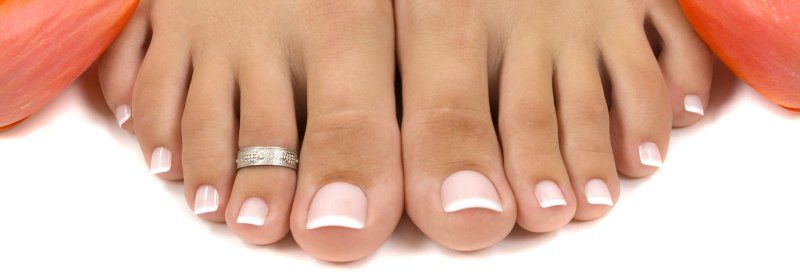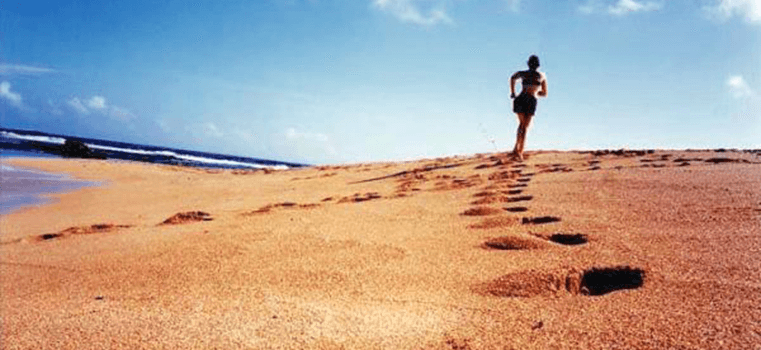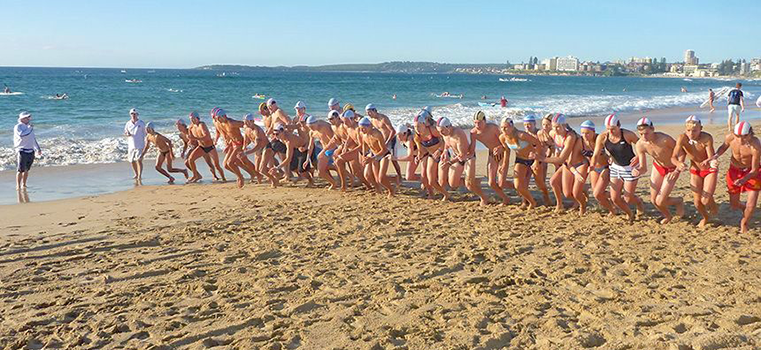Mark Reed, DPM
DABFAS FAPWCA

714-528-3668
Pain by Location Guide
BALL OF THE FOOT PAIN
There are several causes of pain in the ball of the foot. The type of pain and its location help the doctor in determining the cause of the pain and helps to direct them in the best treatment for the patient.
Calluses on the bottom of the foot can be painful. These calluses are caused by an abnormal alignment of the bones behind the toes called metatarsal bones. When there is an abnormal alignment of one or more of these bones, they will experience excessive weight and pressure. The skin thickens in response to this pressure forming the callus. Treatment consists of periodic trimming or shaving the callus, padding the shoes to remove the pressure, functional foot orthotics, or surgery. Surgery should not be contemplated until the use of orthotics has been determined to have failed. The surgery consists of fracturing the involved metatarsal bone to realign it. Following the surgery, the patient should wear an orthotic to prevent the occurrence of new areas of callus. People with diabetes should not trim or shave these areas or use over the counter corn removers.
Pain in the ball of the foot not associated with calluses can be a result of inflammation of a tendon into the toe inflammation of the joint, or due to a pinched nerve called a Neuroma. A neuroma will also often cause a burning pain into one or more toes. Another cause of pain in the ball of the foot is arthritis. Arthritis will usually affect multiple joints in the ball of the foot. Common types of arthritis are rheumatoid arthritis, osteoarthritis and degenerative arthritis. Degenerative arthritis most commonly affects the big toe joint. The big toe joint is often stiff causing jamming (Hallux Limitus). Over time the jamming of the joint will cause an enlargement on the top of the joint.
The most common cause of pain in the ball of the foot, in the area of the big toe joint, is sesamoiditis. Sesamoiditis is an inflammation of two small bones under the big toe joint. On occasion, a stress fracture can occur in one of these bones. Severe pain with sudden onset about the big toe joint may be gout.
TOP OF THE FOOT PAIN
There are several causes of pain on the top of the foot. The type of pain and its location help the doctor in determining the cause of the pain and helps to direct them in the best treatment for the patient.
Pain of sudden onset without the occurrence of injury on the top of the foot just behind the toes may be a stress fracture of a metatarsal bone. There is frequently swelling in the area, and it is painful to the touch.
Another common area of pain occurs near the middle of the top of the foot, generally a bit to the outside of the foot. In this area of the foot the tendons that go to the toes can become inflamed. This is called extensor tendonitis. One cause of this condition is excessive tightness of the calf muscle. When the calf muscle is tight it places excessive stress on the tendons on the top of the foot that pull the foot upward and against the tightness of the calf muscles. Wearing a shoe with a one-inch heel will help to take the stress off of the tendons on the top of the foot. Stretching of the calf muscle is also very helpful. Oral anti-inflammatory medications can help. When these measures do not work a functional orthotic should be tried. The orthotic corrects the alignment of the foot taking the stress off of the tendons on the top of the foot.
More generalized pain on the top of the foot with swelling or a "thickness" to the foot may be caused by degenerative arthritis. This is seen in people with flatfeet or a slowly collapsing arch.
Another area of degenerative arthritis that causes pain on the top of the foot is in the area of the big toe joint. Jamming of the joint will cause bone spurring to occur on the top of the foot. Pressure from the shoe can cause pain. Treatment for these conditions consists of taking oral anti-inflammatory medications and functional foot orthotics. Surgery can be an option for the degenerative arthritis about the big toe joint. (See Hallux Limitus )
Generalized pain in the top of the foot that occurs in children and young adults may be due to a condition called Tarsal Coalition. This pain tends to occur on the outside portion of the top of the foot. A tarsal coalition is the abnormal fusion of two or more bones in the rear portion of the foot. It can be hereditary. It tends to get worse with activity. If not treated in its early stages, it can cause significant arthritis in the foot causing a limitation in the person's activity. Early diagnosis is made using x-rays and an MRI or CT scan. Treatment is with the use of functional orthotics and on occasion surgery. Early diagnosis and treatment are very important.
Pain can also occur on the top and inside of the foot. In people who are very active in sporting activities can develop pain in this area. The pain can be due to a stress fracture of one of the bones (Navicular bone) in this area. Diagnosis can sometimes be difficult. X-rays are generally negative and if a stress fracture is present the diagnosis may require a bone scan or MRI. Treatment consists of rest with a limitation of activity, oral anti-inflammatory medications, below the knee walking casts, functional orthotics or rarely surgical exploration of the area.
Yet another area of pain on the top of the foot is just below the ankle joint on the outside portion of the top of the foot. In this area of the foot there is a small fleshy area. This fleshy area is a small muscle called the Extensor Digatorum Brevis. Underneath the muscle there is a small canal between two bones. This area is called the Sinus Tarsi. In this area there are three small ligaments that can become inflamed. A common cause of this pain is due to a flattening of the foot, which pinches these small ligaments. Sometimes there is actual jamming of two bones causing the pain. Treatment consists of stretching the calf muscles to reduce it effect of flattening the foot, oral anti-inflammatory medication, cortisone injections, functional orthotics and occasionally surgical exploration.
ARCH AND HEEL PAIN
There are several causes of pain in the arch of the foot and heel region. The type of pain and its location help the doctor in determining the cause of the pain and helps to direct them in the best treatment for the patient.
The most common pain in the bottom of the foot is heel pain. This pain tends to be worse first thing in the morning or after rest. It is associated with a tight ligament in the bottom of the foot called the plantar fascia. X-rays will often reveal a spur on the bottom of the heel. (See plantar fasciitis and heel spurs) Pain in the back of the heel can be due to bony enlargements (Hagland's deformity), spurring in the Achilles tendon or Achilles tendonitis. Burning pain in the bottom of the foot may be caused by a condition called tarsal tunnel syndrome or it may be due to peripheral neuropathy. People with diabetes frequently experience burning in the bottom of the feet. Pain in the middle of the arch of the foot that is also associated with small, hard knots may be due to plantar fibromatosis.
BACK OF HEEL PAIN
The common cause of a painful bump on the back of the heel is called Hagland's deformity. This is due to an enlarged bony prominence on the back of the heel. It can involve the entire back of the heel or just a portion of the back of the heel, usually on the outside portion of the heel. Also called the Pump Bump, it is most common in women and is frequently a result of pressure from the back of the shoe. As the shoe rubs on the back of the heel bone it begins to swell and enlarge. Quite often a bursa will form. A bursa is a sack that is created over any bony prominence when excessive pressure or friction to the areas occurs. Bursae can be filled with a thick watery like fluid.
Hagland's deformity
Treatment consists of removing the pressure and avoiding shoes that rub on the back of the heel. Orthotics, custom molded shoe inserts, can be useful because they reduce the rocking motion side-to-side of the heel while walking which aggravates the painful area. Cortisone injections can temporarily reduce the pain or eliminate the pain. Surgery can be the treatment of choice if other means to reduce the pressure are unsuccessful.
Spurring in the Achilles tendon
Closely related to Hagland's deformity is an enlargement that can occur on the back of the heel that is a result of the formation of a large spur where the Achilles tendon attaches. Treatment is the same as with the Hagland's deformity except that the surgical procedure to remove the spurring is more complex and has a longer recovery period.
Achilles Tendonitis
Swelling and lumps can also occur in the Achilles tendon just above its attachment into the heel bone. Termed Achilles tendonitis, this occurs when there is a tear in the tendon. If this goes untreated the tendon is at risk of rupturing. Treatment consists of immobilization with a cast, possibly crutches to take weight off the foot, oral anti-inflammatory drugs and if severe surgery may be necessary. Once the area is healed aggressive physical therapy and calf muscle stretching exercises may be needed. There is another small tendon that attaches in the back of the heel that can become injured. It is called the Plantaris tendon. This tendon can tear or rupture during exercise. It is associated with a sudden onset of pain during exercise and mimics Achilles tendonitis.
Xanthomas
An uncommon cause of small lumps in the Achilles tendon is an excessively high cholesterol level in the blood stream. This is a hereditary disorder that results in the deposition of cholesterol in the Achilles tendon. This is a serious condition and requires aggressive treatment by a physician to lower the cholesterol levels. Left untreated the high cholesterol levels can lead to premature heart attack and death.
BOTTOM OF FOOT PAIN
There are several causes of pain in the arch of the foot and heel region. The type of pain and its location help the doctor in determining the cause of the pain and helps to direct them in the best treatment for the patient.
The most common pain in the bottom of the foot is heel pain. This pain tends to be worse first thing in the morning or after rest. It is associated with a tight ligament in the bottom of the foot called the plantar fascia. X-rays will often reveal a spur on the bottom of the heel. (See plantar fascists and heel spurs)
Pain in the back of the heel can be due to bony enlargements (Hagland's deformity), spurring in the Achilles tendon or Achilles tendonitis.
Burning pain in the bottom of the foot may be caused by a condition called tarsal tunnel syndrome or it may be due to peripheral neuropathy. People with diabetes frequently experience burning in the bottom of the feet.
Pain in the middle of the arch of the foot that is also associated with small, hard knots may be due to plantar fibromatosis .
DISCLAIMER: MATERIAL ON THIS SITE IS BEING PROVIDED FOR EDUCATIONAL AND INFORMATION PURPOSES AND IS NOT MEANT TO REPLACE THE DIAGNOSIS OR CARE PROVIDED BY YOUR OWN MEDICAL PROFESSIONAL. This information should not be used for diagnosing or treating a health problem or disease or prescribing any medication. Visit a health care professional to proceed with any treatment for a health problem.


